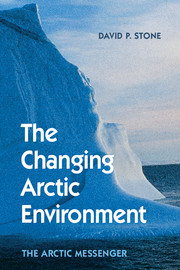Book contents
- Frontmatter
- Dedication
- Contents
- Acknowledgements
- Acronyms
- 1 Personal Beginnings
- PART I THE CHANGING ARCTIC
- PART II WORKING TOGETHER
- PART III WHAT IS THE PRESENT STATE OF KNOWLEDGE?
- PART IV WHAT DOES ALL THIS MEAN?
- 11 Thoughts on Education, the Training of Arctic Scientists, and Arctic Research
- 12 The Long and the Short of It: Has the Arctic Messenger Been Noticed? What Can Be Done?
- 13 Epilogue: Keeping the Rovaniemi Flame Alive
- Appendix I The Intergovernmental Panel on Climate Change (IPCC)
- Appendix II What Will Happen in the Future If We Do Nothing or If We Try Very Hard to Aggressively Reduce GHG Emissions: Projected Change Under Different Emission Scenarios
- Appendix III Some Geophysical Background Notes Related to Climate and Weather
- Appendix IV Orbital Forcing
- Appendix V The Concept of Commitment
- Bibliography
- Credits
- Index
13 - Epilogue: Keeping the Rovaniemi Flame Alive
from PART IV - WHAT DOES ALL THIS MEAN?
Published online by Cambridge University Press: 05 February 2015
- Frontmatter
- Dedication
- Contents
- Acknowledgements
- Acronyms
- 1 Personal Beginnings
- PART I THE CHANGING ARCTIC
- PART II WORKING TOGETHER
- PART III WHAT IS THE PRESENT STATE OF KNOWLEDGE?
- PART IV WHAT DOES ALL THIS MEAN?
- 11 Thoughts on Education, the Training of Arctic Scientists, and Arctic Research
- 12 The Long and the Short of It: Has the Arctic Messenger Been Noticed? What Can Be Done?
- 13 Epilogue: Keeping the Rovaniemi Flame Alive
- Appendix I The Intergovernmental Panel on Climate Change (IPCC)
- Appendix II What Will Happen in the Future If We Do Nothing or If We Try Very Hard to Aggressively Reduce GHG Emissions: Projected Change Under Different Emission Scenarios
- Appendix III Some Geophysical Background Notes Related to Climate and Weather
- Appendix IV Orbital Forcing
- Appendix V The Concept of Commitment
- Bibliography
- Credits
- Index
Summary
“A poisoned Inuk child, a poisoned Arctic and a poisoned planet are all one in the same. We are all in this together.”
Sheila Watt-Cloutier, Inuit advocate on human, cultural and environmental rightsIf we need a précis of the entire tale from the Arctic Messenger, this quote from Sheila Watt-Cloutier says it all.
In this final and short chapter, our tale will come to an end. Our last act will be to speculate about what the Arctic Messenger would (if it were able) ask Arctic Council governments to do at this moment in time. But as a prelude before we dive into the fray, I want to spend a little time refreshing our memories about the unique nature of the Arctic Council. At the same time, we can remind ourselves about some key individuals and developments that have made the Arctic Council into the capable circumpolar organisation in which the Arctic Messenger would expect to find a strong ally. They have taught us lessons we would be wise to keep in mind. Their work has succoured the “Rovaniemi flame” – that innervating spirit that gave the Arctic Messenger a voice. Over the last 20 years, the council has exposed the dilemma captured by Sheila-Watt Cloutier's words and we need it now more than ever before.
Lessons From Heroines and Heroes: From Rovaniemi to the Arctic Council
Until 1989–1991, no advocate existed that combined the capacity of putting its finger on the pulse of the Arctic environment with the responsibility to simultaneously advise Arctic governments on the status of the patient's health. No mechanism existed that would empower governments to consider responding to such advice with cooperative environmental protection measures. All that suddenly changed in 1989 with the bold initiative of Kalevi Sorsa, Kaj Barlund and the Finnish government. In a clever and practical suggestion, they showed how the environmental elements of Mr. Gorbachev's 1987 Murmansk speech could easily be put into action without any complicated legal agreement.
- Type
- Chapter
- Information
- The Changing Arctic EnvironmentThe Arctic Messenger, pp. 300 - 306Publisher: Cambridge University PressPrint publication year: 2015



